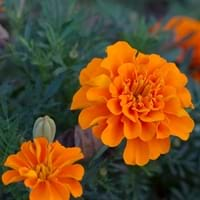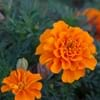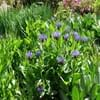Life Span
Annual
Perennial
Type
Flowering Plants, Shrubs
Shrub
Origin
Hybrid origin
Hybrid origin, Southwestern United States
Types
African or American Marigolds, French Marigolds, Mule Marigolds
Not Available
Number of Varieties
Not Available
Habitat
Roadsides, wastelands
riparian zones, Semi desert, Upland
USDA Hardiness Zone
9-11
8-10
Sunset Zone
A1, A2, A3, H1, H2, 1a, 1b, 2a, 2b, 3a, 3b, 4, 5, 6, 7, 8, 9, 10, 11, 12, 13, 14, 15, 16, 17, 18, 19, 20, 21, 22, 23, 24
7, 8, 9, 10, 11, 12, 13, 14
Habit
Upright/Erect
Spreading
Flower Color
Orange, Yellow
White
Flower Color Modifier
Bicolor
Not Available
Fruit Color
Not Available
creamy white
Leaf Color in Spring
Green
Green
Leaf Color in Summer
Dark Green
Green
Leaf Color in Fall
Dark Green
Green
Leaf Color in Winter
Dark Green
Green
Leaf Shape
Toothed
Oblanceolate , Ovate
Plant Season
Fall, Spring, Summer
Spring, Summer, Fall, Winter
Sunlight
Full Sun, Part sun
Full Sun
Growth Rate
Very Fast
Slow
Type of Soil
Loamy, Sandy, Well drained
Clay, Loam, Sand
The pH of Soil
Neutral, Slightly Alkaline
Acidic, Neutral, Alkaline
Soil Drainage
Well drained
Well drained
Bloom Time
Early Fall, Early Summer, Fall, Late Fall, Late Summer, Summer
Spring
Tolerances
Drought
Drought, Dry soil, Heat Tolerance
Where to Plant?
Container, Ground, Pot
Ground, Pot
How to Plant?
Seedlings
Seedlings
Plant Maintenance
Medium
Medium
Watering Requirements
Allow soil to be completely dry in between waterings, Form a Soil ring to water efficiently, Keep the ground moist but not water-logged, Water in morning to avoid prompting diseases, Water when soil is dry
Needs very little water
In Summer
Lots of watering
Lots of watering
In Spring
Moderate
Moderate
In Winter
Average Water
Average Water
Soil pH
Neutral, Slightly Alkaline
Acidic, Neutral, Alkaline
Soil Type
Well drained
Clay, Loam, Sand
Soil Drainage Capacity
Well drained
Well drained
Sun Exposure
Full Sun, Part sun
Full Sun
Pruning
Prune ocassionally, Remove dead or diseased plant parts, Requires little pruning
Cut back old stems to the ground, Remove damaged leaves, Remove dead branches, Remove dead leaves
Fertilizers
All-Purpose Liquid Fertilizer
can go long without fertilizers
Pests and Diseases
Alternaria Leaf Spot, Bacterial leaf spot, Damping-off, Gray mold, Powdery mildew, Root rot
Pests and diseases free
Plant Tolerance
Drought
Dry Conditions, Dry soil, Heat And Humidity
Flower Petal Number
Single
Single
Fragrant Bark/Stem
Yes
No
Foliage Texture
Fine
Fine
Foliage Sheen
Matte
Glossy
Attracts
Butterflies
Butterflies
Allergy
Asthma, Eye irritation, Red eyes, Runny nose, Throat itching, Watery eyes
Unknown
Aesthetic Uses
Showy Purposes
along a porch, deck or patio, Beautification, Ground Cover, Showy Purposes, Wild gardens
Beauty Benefits
Not Available
Not Available
Edible Uses
Yes
Sometimes
Environmental Uses
Air purification
Air purification
Medicinal Uses
Burns, constipation, Inflammation, Upset stomach, Wounds
anti-inflammatory, Anti-oxidant, cholesterol-lowering
Part of Plant Used
Flowers, Seeds
Twigs
Other Uses
Can be made into a herbal tea, Decoration Purposes, Used As Food
Can be made into a herbal tea
Used As Indoor Plant
Yes
No
Used As Outdoor Plant
Yes
Yes
Garden Design
Bedding Plant, Edging, Foundation, Houseplant, Mixed Border
Groundcover
Botanical Name
TAGETES 'Cottage Red'
BACCHARIS 'Centennial'
Common Name
Marigold
desert broom , broom baccharis , greasewood
In Hindi
गेंदा
desert broom
In German
Ringelblume
Wüste Besen
In French
Souci
desert broom
In Spanish
Caléndula
escoba del desierto
In Greek
κατιφές
desert broom
In Portuguese
Malmequer
vassoura do deserto
In Polish
Nogietek
desert broom
In Latin
Caltha
desert broom
Phylum
Tracheophyta
Magnoliophyta
Class
Magnoliopsida
Magnoliopsida
Order
Asterales
Asterales
Family
Asteraceae
Asteraceae
Clade
Not Available
Angiosperms, Asterids, Eudicots
Tribe
Not Available
Astereae
Subfamily
Not Available
Not Available
Number of Species
Not Available
Properties of Marigold and Desert Broom
Wondering what are the properties of Marigold and Desert Broom? We provide you with everything About Marigold and Desert Broom. Marigold doesn't have thorns and Desert Broom doesn't have thorns. Also Marigold does not have fragrant flowers. Marigold has allergic reactions like Asthma, Eye irritation, Red eyes, Runny nose, Throat itching and Watery eyes and Desert Broom has allergic reactions like Asthma, Eye irritation, Red eyes, Runny nose, Throat itching and Watery eyes. Compare all the properties and characteristics of these two plants. Find out which of these plant can be used as indoor plant. If you are interested to decorate your house and garden, find out aesthetic uses, compare them and select the plant which will beautify your surrounding. Along with beautification, try comparing medicinal and edible uses of Marigold and Desert Broom and you can choose the plant having best and most benefits.
Season and Care of Marigold and Desert Broom
Season and care of Marigold and Desert Broom is important to know. While considering everything about Marigold and Desert Broom Care, growing season is an essential factor. Marigold season is Fall, Spring and Summer and Desert Broom season is Fall, Spring and Summer. The type of soil for Marigold is Loamy, Sandy, Well drained and for Desert Broom is Clay, Loam, Sand while the PH of soil for Marigold is Neutral, Slightly Alkaline and for Desert Broom is Acidic, Neutral, Alkaline.
Marigold and Desert Broom Physical Information
Marigold and Desert Broom physical information is very important for comparison. Marigold height is 40.00 cm and width 50.00 cm whereas Desert Broom height is 60.00 cm and width 150.00 cm. The color specification of Marigold and Desert Broom are as follows:
Marigold flower color: Orange and Yellow
Marigold leaf color: Green
Desert Broom flower color: White
- Desert Broom leaf color: Green
Care of Marigold and Desert Broom
Care of Marigold and Desert Broom include pruning, fertilizers, watering etc. Marigold pruning is done Prune ocassionally, Remove dead or diseased plant parts and Requires little pruning and Desert Broom pruning is done Cut back old stems to the ground, Remove damaged leaves, Remove dead branches and Remove dead leaves. In summer Marigold needs Lots of watering and in winter, it needs Average Water. Whereas, in summer Desert Broom needs Lots of watering and in winter, it needs Average Water.





